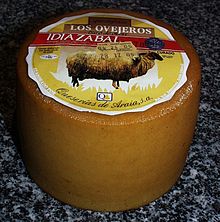
Manchego is a cheese made in the La Mancha region of Spain from the milk of sheep of the Manchega breed. It is aged between 60 days and 2 years.
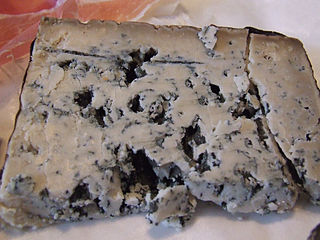
Cabrales is a blue cheese made in the artisan tradition by rural dairy farmers in Asturias, Spain. This cheese can be made from pure, unpasteurized cow’s milk or blended in the traditional manner with goat and/or sheep milk, which lends the cheese a stronger, spicier flavor.

Mizithra or myzithra is a Greek whey cheese or mixed milk-whey cheese from sheep or goats, or both. It is sold both as a fresh cheese, similar to Italian ricotta, and as a salt-dried grating cheese, similar to Italian ricotta salata. The ratio of milk to whey usually is 7 to 3.

Goat cheese, goat's cheese, or chèvre is cheese made from goat's milk. Goats were among the first animals to be domesticated for producing food. Goat cheese is made around the world with a variety of recipes, giving many different styles of cheeses, from fresh and soft to aged and hard.

Camembert is a moist, soft, creamy, surface-ripened cow's milk cheese. It was first made in the late 18th century in Camembert, Normandy, in northwest France. It is sometimes compared in look and taste to brie cheese, albeit with a slightly lower butterfat content than brie's typically 20% - 25% by weight.

Asiago is a cow's milk cheese, first produced in Asiago in Italy, that can assume different textures according to its aging, from smooth for the fresh Asiago to a crumbly texture for the aged cheese. The aged cheese is often grated in salads, soups, pastas, and sauces while the fresh Asiago is sliced to prepare panini or sandwiches; it can also be melted on a variety of dishes and cantaloupe. It is classified as a Swiss-type or Alpine cheese.
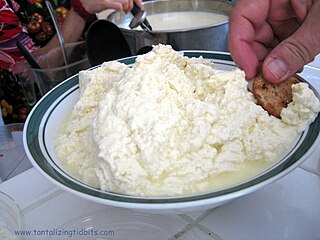
Ricotta is an Italian whey cheese made from sheep, cow, goat, or Italian water buffalo milk whey left over from the production of other cheeses. Like other whey cheeses, it is made by coagulating the proteins that remain after the casein has been used to make cheese, notably albumin and globulin.

Abbaye de Belloc is a French Pyrenees, traditional farmhouse, semi-hard cheese from the Pays Basque region, made from unpasteurized sheep milk, with a fat content of 60%. The cheese is still made in the traditional manner by the Benedictine monks of the Abbaye Notre-Dame de Belloc, in the commune of Belloc in the Ariège department of southwestern France. Production of this Ossau-Iraty cheese is regulated by A.O.C. laws. Abbaye is produced from the milk of a centuries-old breed of red-nosed Manech ewes, particular to the Basque region, delivered by farms neighboring Belloc Abbey. It is believed that these Benedictine monks were the first to teach shepherds from the Basque region how to make cheese many centuries ago. Abbaye de Belloc has a pleasantly nutty and complex flavor that is characteristic of Basque, and is made in a 5 kg fat wheel with a natural, crusty, brownish colored rind with patches of red, orange and yellow. This semi-firm cheese has a dense, rich and creamy texture and a distinctive lanolin aroma. Careful attention under the correct maturing conditions accentuates this cheese's rich, caramelized flavors, which sometime resemble burnt caramel, that can make Abbaye de Belloc so addictive. It pairs particularly well with Pinot Noir, as it is mild enough not to overwhelm the subtleties of this delicate varietal, but also has sufficient complexity to stand up to the bolder flavors of a Syrah/Shiraz.

Cheese is a dairy product produced in a wide range of flavors, textures, and forms by coagulation of the milk protein casein. It comprises proteins and fat from milk. During production, milk is usually acidified and either the enzymes of rennet or bacterial enzymes with similar activity are added to cause the casein to coagulate. The solid curds are then separated from the liquid whey and pressed into finished cheese. Some cheeses have aromatic molds on the rind, the outer layer, or throughout.
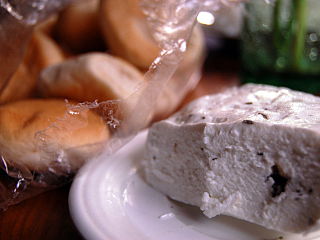
Kesong puti is a Filipino soft, unaged, white cheese made from unskimmed carabao milk and salt curdled with vinegar, citrus juices, or sometimes rennet. It can also be made with goat or cow milk. It has a mild salty and tart flavor. When an acidifying agent is used, it resembles queso blanco or paneer. When rennet is used, it resembles buffalo mozzarella. Moisture content can also vary, ranging from almost gelatinous to pressed and firm. It can be eaten as is, paired with bread, or used in various dishes in Filipino cuisine. It is usually sold wrapped in banana leaves.

Caprino is an Italian cheese traditionally made from whole or skimmed goat's milk. The name of the cheese derives from the Italian word for goat, capra. With modern methods of production, the cheese is made from cow's milk as well or a combination of both cow's and goat's milks. The two major styles of caprino are fresco ("fresh") and stagionato ("aged").

There are many different types of cheese. Cheeses can be grouped or classified according to criteria such as length of fermentation, texture, methods of production, fat content, animal milk, and country or region of origin. The method most commonly and traditionally used is based on moisture content, which is then further narrowed down by fat content and curing or ripening methods. The criteria may either be used singly or in combination, with no single method being universally used.

The Latxa is a breed of domestic sheep native to the Basque Country of Spain. Mostly contained within the provinces of Biscay, Gipuzkoa and Navarre, Latxa are dairy sheep whose unpasteurized milk is used to produce Idiazábal and Roncal cheeses. There are two sub-types of the breed, a dark-faced and a blonde.

Cheeses in Mexico have a history that begins with the Spanish conquest, as dairy products were unknown in pre-Columbian Mesoamerica. The Spanish brought dairy animals, such as cattle, sheep, and goats, as well as cheesemaking techniques. Over the colonial period, cheesemaking was modified to suit the mixed European and indigenous tastes of the inhabitants of New Spain, varying by region. This blending and variations have given rise to a number of varieties of Mexican cheeses. These are most popular in the country, although European cheeses are made, as well. Almost all cheese in Mexico is made with cows’ milk, with some made from goats’ milk. More recently, efforts have been made to promote sheep's milk cheeses. Most cheeses are made with raw (unpasteurized) milk. Cheeses are made in the home, on small farms or ranches, and by major dairy product firms. Between 20 and 40 different varieties of cheese are made in Mexico, depending on how one classifies them. Some, such as Oaxaca and panela, are made all over Mexico, but many are regional cheeses known only in certain sections on the country. Some of the least common are in danger of extinction.
Alpujarras cheese is a Spanish cheese from the eastern region of Andalusia, which includes the provinces of Granada, Almería and the Penibética mountain chain. The cheese takes its name from La Alpujarra, a mountainous region which occupies a part of southern Granada province and western Almeria province. This area has a long history and tradition of goatherding. Alpujarras cheese is made from the milk of the White Andalusian domesticated goat.

Flor de Guía cheese is a Spanish cheese made on the island of Gran Canaria in the Canary Islands. It has Denomination of Origin protection. The cheese is classified as fatty or semi-fatty and made from the milk from Canarian sheep, with milk from Canarian cows and/or goats. The milk from the sheep must constitute at least 60% and cows’ milk content must never exceed 40%. Goat milk must never exceed 10% of the mixture. The cheese is presented in flat cylindrical cheeses which normally measure 4–8 cm high and 20–30 cm across and weighing between 2 and 5 kg. The cheese gets its name from an area in northern Gran Canaria called Santa María de Guía, where the cheese is made, and ‘flor’ from the fact that juice from the flowerheads of a species of cardoon and globe artichoke are used to curdle the milk.

Palmero cheese is a Spanish plain or lightly smoked cheese from the island of La Palma in the Canary Islands. It is made of unpasteurised goats milk and has Denomination of Origin protection. The goats are free to graze on natural wild plants which are available all year round. The cheese is made on many small farms all over the island. It is presented in cylindrical cheeses of up to 15 kilos (33 lbs).
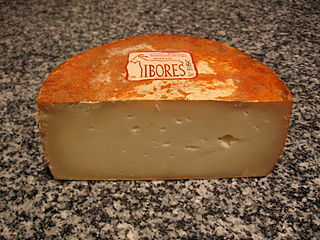
The Ibores cheese is a Spanish cheese made from unpasteurized goats’ milk in Extremadura. It has a Denomination of Origin protection in the European Union and is made specifically in the districts of Ibores, Villuercas, La Jara y Trujillo in the south east of the Province of Cáceres. It is a fatty cheese made exclusively from the milk of Serrana, Verata, Retinta breeds and crosses between them and only from farms registered with the regulatory council. The cheeses are flat cylindrical and measure 5–9 cm (2-3.5 inches) high and 11–15 cm (4-6 inches) across. They weigh from 600 to 1200 g (1-2 lbs).
Cantabrian cream cheese is made from the milk of Friesian cows in Cantabria, an autonomous community in northern Spain. The cheese has a Protected Designation of Origin since 1985. The production of the cheese is confined to all parts of Cantabria, except the areas of Tresviso and Menor de Bejes in the western part of the region. It is presented in forms of various weights from 400 – 2,800 g. The size of the forms varies according to the weight.
